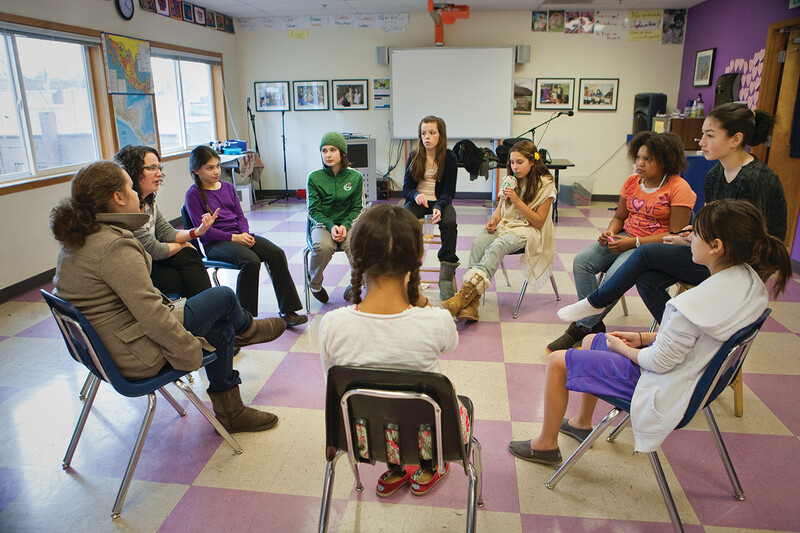Research Alert
Social Justice Curriculum Can Change Lives
Students who take a service learning or social justice course in high school often feel empowered and motivated right after they complete the class—but do these benefits last into adulthood? To address this question, researcher Marinda K. Harrell-Levy at Pennsylvania State University studied the long-term effects of a social justice course on black students who had taken the course in 11th grade.
Fifteen years later, the 13 individuals whom Harrell-Levy interviewed consistently said that the course had transformed their sense of justice and influenced their view of themselves as change agents. Eleven of the subjects reported that the course had led them toward socially beneficial professions such as social work, law, and education.
The curriculum also apparently provided an opportunity for students to examine intra-racial stereotypes. One surprising finding was that the participants who regarded themselves as economically privileged reported that the course had challenged their negative perceptions of black individuals—and others—who live in poverty.
"'Minds Were Forced Wide Open': Black Adolescents' Identity Exploration in a Transformative Social Justice Class" (Education, Citizenship and Social Justice, July 2016) is available for a fee at http://esj.sagepub.com/content/11/2/99.
Relevant Read
Our Kids: The American Dream in Crisis by Robert D. Putnam (Simon & Schuster, 2015)
The American dream has long conjured up images of self-made individuals from low-socioeconomic backgrounds who have pulled themselves up by their bootstraps and launched successful careers despite beginning with only a few dollars to their names. In this book, Robert Putnam (author of Bowling Alone) argues that this dream is in crisis and that upward socioeconomic mobility is a thing of the past.
He asks, "Do youth today coming from different social and economic backgrounds in fact have roughly equal life chances?" The answer, as you may guess, is no. Using a mix of human stories and data, he takes on class inequality and tackles how the class-based opportunity gap has widened in the past several decades. Putnam looks at how changes in family structures, parenting, schooling, and communities have affected—and been affected by—this gap. He ends with a chapter about what can be done to narrow the opportunity gap—solutions as complex as they are politically controversial.
Numbers of Note
What Does Data Tell Us About Inequity?
67% Students with disabilities (who make up 12 percent of the student population) represent 67 percent of students who are placed in seclusion or are physically restrained at school.
3% Fewer than 3 percent of students in gifted and talented programs are English language learners.
3.8x Black K–12 students are 3.8 times more likely than white students to receive one or more out-of-school suspensions.
800,000 Nearly 800,000 students are enrolled in schools where more than 20 percent of teachers have not met certification or licensure requirements. Black, Latino, and American Indian or Alaska Native students are more likely to attend these schools.
Source: 2013–2014 Civil Rights Data Collection from the U.S. Department of Education, Office for Civil Rights: http://www2.ed.gov/about/offices/list/ocr/docs/2013-14-first-look.pdf
Page Turner
"Every one of us is touched by racism. We all have a stake in positive race relations."
Screen Grab
Inequities in Independent Schools
A documentary called American Promise follows two black students named Idris and Seun on their journeys from kindergarten through 12th grade. Both boys start out attending a prestigious private school in New York City. Even in their early years, they struggle with racial identity and implicit bias in a predominately white environment. As a young child, Idris understands the difficulties of code switching—recounting how the black basketball teammates from his neighborhood make fun of him for "speaking like a white boy." As they grow, the two boys take different paths, as one stays at the private school and the other switches to a public school. The film highlights the challenges that students of color face in independent schools and the pressures that parents place on their children.
The full-length documentary is available on Hulu (with subscription) and for a fee from Amazon Video, iTunes, and other video providers. A condensed video op-doc is available free at www.nytimes.com/2013/09/24/opinion/an-education-in-equality.html.
Online Only
A Picture of Funding Disparities
An interactive map created by the nonprofit group EdBuild provides evidence that similar U.S. school districts spend radically different amounts on their students, "revealing systemic and unjustifiable inequities in the way we fund our schools."
One version of the map shows the amount by which school funding in every U.S. school district differs from the average per-pupil revenue in all districts in the nation ($11,866), adjusted for local variations in the cost of living. Another version displays student poverty rates in the same districts. The maps indicate that districts vary widely in the resources they have available for their students—and that districts with the greatest need receive fewer resources. The poorest districts, says EdBuild, receive 21 percent less funding than the wealthiest ones do.
To view the maps, go to http://viz.edbuild.org/maps/2016/cola/arbitrary/text.html.



